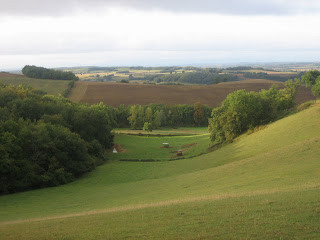Every day I walk myself into a state of well-being and walk away from every illness. SØREN KIERKEGAARD
Yes, it was another day, and a much better one. For a start my feet felt renewed. What a difference a day makes! I'd removed the 'Superfeet' insoles from my boots which afforded some temporary relief from the foot pain. (Though I know these insoles are very well thought of, I suspect ideally you need to have special custom-made ones moulded to the shape of each foot - particularly if you have a foot problem. Would be interested in any comments.) Also - how could your spirit fail to be uplifted on walking through lovely countryside such as this? I love the curve of the field. It's like a rolling, green wave ...

Later I came across this rustic box-like structure attached to a tree. The wooden cross seems to be intentionally a Christian cross - but I'm not really sure. I've still no real idea as to its purpose. Any ideas, anyone? Below it is a beautifully clear waymarker. Would they were all like this! The white and red stripe (balise in French) denotes a GR (Grande Randonnée) long distance footpath - there's a network of these paths covering much of Europe. The path I'd been following from Arles was the GR653. And of course the yellow starburst or scallop shell sign on a blue background indicates Le Chemin de Compostelle.

This old Massey Ferguson tractor had just been left to moulder away. I think it must be around 50 years old. Any tractor enthusiasts out there to give the model an exact date?

The signpost showed conclusively that the trials of Barran were now far behind me. The Virgin and Child were pointing the way ...

... to another sculpture, this time of a one-armed Saint-Jacques, on the outskirts of Montesquiou (note the scallop shells on his cloak). The sign above Saint-Jacques reads: Arles 540 km Compostelle 935 km. So I'd walked more than 500 km already!

A sudden rain shower descended on the sleepy village of Montesquiou. I retreated into the bar below for a beer ... or two ...

... and later passed this wayside calvary ...

... on the way to the campsite of Le Château de Haget. I spent the night there in a chalet which I shared with 2 other walkers. It was quite common for campsites to provide chalet or caravan accommodation for pilgrims on a nightly basis in the out-of-season months. This is a pic of the turreted castle at the campsite. Not bad, huh?

6 comments:
I love that quote at the top. I did that! Still doing it in fact.
x
Robert - re feet: I had special orthotics made for my feet at an astronomical cost of £300 and I wore them for a year before a locum doctor told me to take them out of my shoes as they probably did more harm than good. My plantafascilities cleared up of its own accord eventually so do not despair.
Robert, we are now taking French lessons, so next year won't be so totally out of it. Anyway, my plantar f... is almost cleared up after 2 years. The only thing I've done consistently is avoided going barefoot, even to the bathroom in the middle of the night. The other thing is that when it is in a bothersome period, I stretch it in the morning before starting to walk - just grab the ball of the foot and pull up firmly for about 30 seconds.
Thanks all for the advice...
You touched on way-marking and navigation. My (limited) experience of the GR system in the Auvergne is that away from the more popular areas (the higher mountains) the paths are often overgrown and/or necessitate climbing over barbed wire fences etc. Did you often have problems with non-existent paths?
I didn't have too many problems with the GR653 (from Arles)or last year's GR65 (from Le Puy) - you could almost follow them without a guide book if you kept your wits about you - particularly the GR65, which is the better waymarked of the two. (I didn't even take maps - and relied on the guide books alone - the maps in the books, often no more than diagrams, were hardly detailed, but they 'did the job'.) The paths all existed 'on the ground' without obstruction. Then again, you would expect this as both these long-distance paths double as recognised 'Ways of St James', so they get a fair amount of pilgrim traffic as well as use by other walkers - especially the GR65.
Re other GR paths, my experience is limited like your own - but I believe you are right. Someone told me that even well known GR paths like the GR10 in the Pyrenees (from the Atlantic to the Med) have poorly waymarked patches. I think a good map would be essential for the less well known GRs. (I've also heard that the other two French 'Ways of St James' - one from Paris via Tours and one from Vezelay - are very poorly waymarked indeed).
Incidentally, you may already know this, but as well as the white-and-red stripe markers, the better GRs all have a system of white-and-red crosses too - which indicate 'Not This Way'. This is incredibly useful.
Post a Comment